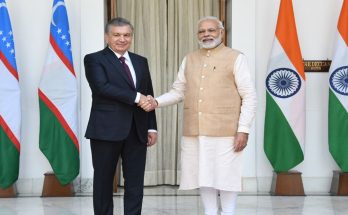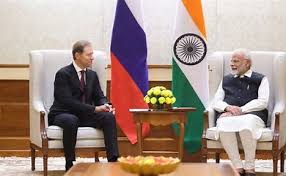 The Narendra Modi government has made energy security an important feature of its foreign policy, with some big ticket energy deals being signed. One major step in this regard related to regional energy security, when India, along with other South Asian countries, signed a regional cooperation agreement on electricity trade during the SAARC summit at Kathmandu. Under this agreement, Pakistan, India, Sri Lanka and Bangladesh would be able to import electricity from hydropower-rich Nepal and Bhutan.
The Narendra Modi government has made energy security an important feature of its foreign policy, with some big ticket energy deals being signed. One major step in this regard related to regional energy security, when India, along with other South Asian countries, signed a regional cooperation agreement on electricity trade during the SAARC summit at Kathmandu. Under this agreement, Pakistan, India, Sri Lanka and Bangladesh would be able to import electricity from hydropower-rich Nepal and Bhutan.
But going by past experience, merely signing an agreement will not suffice. Several SAARC initiatives in the past failed to take off due to inherent political differences among its member nations. In addition to differences between ruling dispensations, opposition parties in some South Asian countries also held diverging view points on energy trade and often opposed projects for political gains thereby discouraging real time investment. For example, Nepal, a country with huge hydropower potential, has been unable to create a conducive environment for energy development due to this factor. Bangladesh also saw a similar trend, wherein political parties prevented any export of natural gas to India.1
In the present context, to make the energy agreement work, it would be necessary for the respective governments to provide leadership and direction on energy issues. The success of this initiative not only rests on individual governments in the eight countries, but also on the political behaviour of some opposition groups within these countries.
Currently, energy cooperation among SAARC members is occurring at a bilateral level. India imports about 1416 MW of electricity from Bhutan2 and it has begun to export electricity to Bangladesh. India’s cooperation with Nepal has resumed in the form of construction of mega projects through private investments like the Upper Karnali power project.
The rationale for signing the SAARC electricity trade agreement was the impending domestic energy crisis faced by individual member countries. For instance, Pakistan is struggling to meet its rising energy demands. In October 2014, it concluded the CASA 1000 power project with the aim of importing electricity from the Central Asian states of Tajikistan and Kyrgyzstan via Afghanistan. But the continuing instability in Afghanistan renders the project unsustainable and unfeasible. It is therefore being compelled to look eastwards for its energy needs. Similarly, Nepal faces a severe power shortage despite being extremely rich in hydropower.
Signing of the SAARC agreement is merely the first step in the process of regional energy cooperation. To make this initiative work, the governments within the region will need to synchronise their efforts on a range of technical, institutional and political issues. Unless there exists a strong political will3 among the participating countries for a sustained period of time, this initiative faces the danger of meeting a fate similar to that of several other proposals under SAARC. The fundamental problem with SAARC remains that the member nations do not trust each other. It is often seen in SAARC that a commercially viable initiative gets side lined due to overarching political differences among the participants.
But fortunately, with time, things appear to be changing and in the last few months there has been a sea change in the attitudes of some south Asian countries towards India. This could possibly be attributed to the growing perception about the firm decision making ability of the new Indian government. Also, as Professor S. D. Muni remarked during the recently concluded 8th South Asia Conference held on 28-29 October 2014 at the Institute for Defence Studies and Analyses, the new Indian government has indicated its willingness to step up cooperation with countries of the region. The first sign in this regard was the invitation extended to the leaders of South Asian countries to attend the swearing in ceremony of the Narendra Modi government. It is time for all the countries of the region to cash on to this new wave of optimism in order to ensure that their energy needs are secured.
Three policy initiatives are key to moving things forward in the energy sector. Firstly, for the development of regional energy trade, the private sector must be allowed to participate. Unlike governments, the private sector has better resources to execute projects. Many South Asian countries do not have the financial wherewithal to make investments. Even India, which happens to be the single largest economy in South Asia, is facing challenges when it comes to financing some energy projects. For example, the funding for some Indian-sponsored hydropower projects in Bhutan had to be postponed due to lack of adequate funding from India.4 In such circumstances, the private sector must be allowed to pitch in with investments and technology to enable the speedy execution of proposed projects.5
Secondly, given the tumultuous nature of South Asian politics, private investors would be less forthcoming to invest in hydropower projects unless the necessary legal regimes are put in place. It would be useful for SAARC countries to either consider joining the Energy Charter treaty6 which entails the signatories to accord national treatment to investors of other member countries7 or put in place a regional version of the energy charter treaty to protect investments. Such steps would make the recently signed SAARC initiative more effective and insulate it from changing political circumstances.
Thirdly, it is important to put in place the technical infrastructure for greater energy connectivity. During a recent field trip to Nepal and Bhutan, respondents often complained to this author about the lack of grid discipline on the Indian side. It is important for India to rectify such technical shortcomings to facilitate regional power exchange.
(The writer is currently Visiting Fellow at the Non-Traditional Security Cluster in IDSA, New Delhi)
Views expressed are of the author and do not necessarily reflect the views of the IDSA or of the Government of India
Author Profile
- India Writes Network (www.indiawrites.org) is an emerging think tank and a media-publishing company focused on international affairs & the India Story. Centre for Global India Insights is the research arm of India Writes Network. To subscribe to India and the World, write to editor@indiawrites.org. A venture of TGII Media Private Limited, a leading media, publishing and consultancy company, IWN has carved a niche for balanced and exhaustive reporting and analysis of international affairs. Eminent personalities, politicians, diplomats, authors, strategy gurus and news-makers have contributed to India Writes Network, as also “India and the World,” a magazine focused on global affairs.
Latest entries
 DiplomacyOctober 4, 2025UNGA Resolution 2758 Must Not Be Distorted, One-China Principle Brooks No Challenge
DiplomacyOctober 4, 2025UNGA Resolution 2758 Must Not Be Distorted, One-China Principle Brooks No Challenge India and the WorldJuly 26, 2025MPs, diplomats laud Operation Sindoor, call for national unity to combat Pakistan-sponsored terror
India and the WorldJuly 26, 2025MPs, diplomats laud Operation Sindoor, call for national unity to combat Pakistan-sponsored terror India and the WorldJuly 25, 2025When Fire Ends, Diplomacy Begins
India and the WorldJuly 25, 2025When Fire Ends, Diplomacy Begins India and the WorldJuly 16, 2025Operation Sindoor and its Aftermath: India’s Successful Diplomatic Outreach
India and the WorldJuly 16, 2025Operation Sindoor and its Aftermath: India’s Successful Diplomatic Outreach







